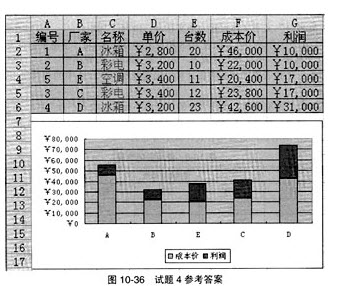创建名为“利润清单”的工作表(内容如表10-6所示),按照题目要求完成后,用Excel的保存功能直接存盘。

[要求]
1.全部单元格的行高、列宽设为最合适的高度和宽度,表格要有可视的外边框和内部边框(格式任意),表格内容水平居中。
2.表中的利润需要用公式计算。然后按利润从低到高排列,若利润相等,再按单价从低到高排列,若单价也相等,再按成本价从低到高排列。
3.为成本价、单价、利润三列添加人民币符号并设置千位位分隔符,将表格中“名称”一列改为红色字体,并为整个表格添加合适的灰色底纹。
4.以“厂家”为横坐标,“成本价”和“利润”为数据区域插入图表,类型为堆积柱形图,图例位于底部。
参考答案:
参考答案:如图10-36所示。

解析:
表格尺寸的设置、表格边框设置以及内容格式的设置,输入公式,使用排序功能及数据图表的插入。
操作的关键步骤如下。
(1) 表格尺寸设置:略。
(2) 表格边框设置:略。
(3) 公式使用:利润的计算公式为单价×台数-成本价。先计算最上面一个单元格中的利润,利用公式复制或拖动“填充柄”将公式复制到其余需要计算利润的单元格。
(4) 排序:选择“数据”菜单下的“排序”命令,在弹出的“排序”对话框中,第一关键字选择“利润”,次要关键字选择“单价”,第三关键字选择“成本价”,默认都是按升序排序。然后单击“确定”按钮。
(5) 单元格内容格式设置:①选取表格,单击“格式”菜单下的“单元格”命令,在弹出的对话框的“图案”选项卡中设置表格的底纹。②选取名称列的数据区,直接单击工具栏上的“字体颜色”按钮设置字体颜色或者通过字体命令来设置字体颜色。③选取成本价、单价、利润三列的数据区(可配合Ctrl进行选取),单击“格式”菜单下的“单元格”命令,在弹出的对话框的“数字”选项卡中,设置分类为“货币”,小数位数为0。
(6) 数据图表的插入:选择“插入”菜单下的“图表”命令,弹出“图表向导”,第一步选择堆积柱形图,第二步在“系列”选项卡中选择好“系列”和“分类轴标志”,第三步选择图例位置为底部,第四步选择“作为其中的对象插入”,单击“完成”按钮即可。可调整图表的位置和大小。
